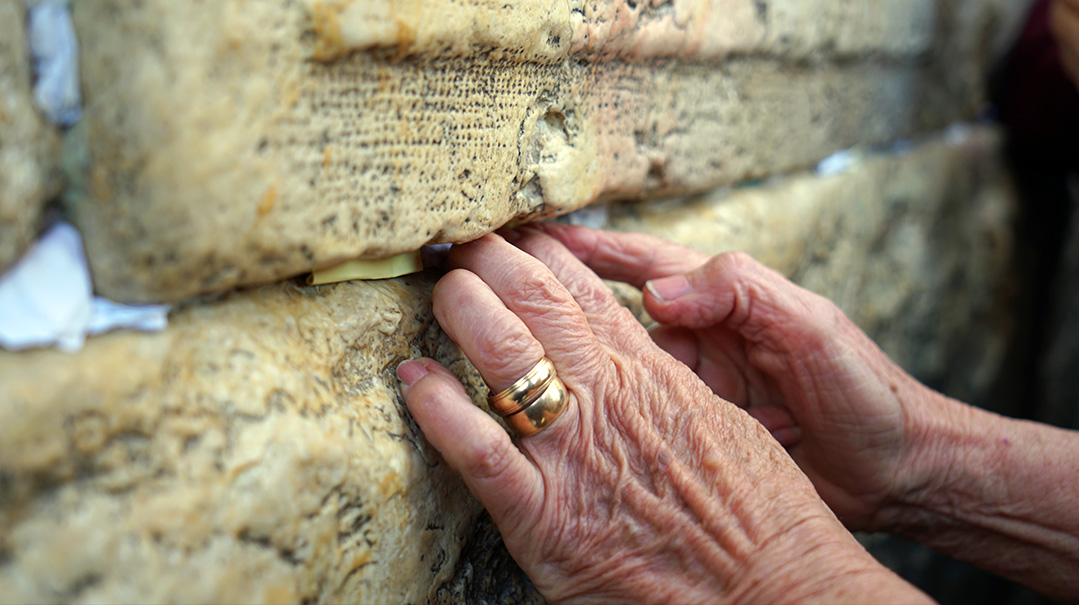Rabbanit of the Kosel

She's a fixture at the Kosel for years and years, as diminutive and as glowing as the first time I met her

As told to Rivka Streicher
W
e come every week, every Motzaei Shabbos.
When we first arrived in Eretz Yisrael, and breathed in the wonder of aliyah — us, Americans, on Israeli soil, living within walking distance of the Kosel? — we knew we couldn’t take it for granted.
And walk we do. On starry Jerusalem nights; when the air is cool and when it’s muggy; when it’s pouring cats and dogs and the tunnels overflow with blessed rainwater.
We try to make it to the Kosel every week. Not for long — just a few minutes of connection in front of His Wall to thank Him for the week that has passed and ask Him for another.
One Motzaei Shabbos, I’m taking a seat in one of the white plastic chairs when an old woman taps me on the shoulder. “Selichah, you shouldn’t be sitting like that.” She motions with her hands, overlapping them, “With your legs crossed. It’s the halachah.”
I uncross my legs, sit up straight, and watch the woman. She’s tiny, hunched over, almost swallowed by the crowd, but her face reflects the moon. Galaxies shine in her eyes. I see her approaching others, tapping them lightly on shoulders, chairs, laps, speaking her few words, safeguarding the sanctity of the Kosel. She’s a force to be reckoned with, a woman on a mission.
On subsequent Kosel trips, I start to notice her, look out for her, this short, tichel-clad, radiant woman. I see people approach her. She whispers brachos, presses coins and taffies into hands, offers firm, warm squeezes and handshakes.
In my mind, she becomes the Rabbanit of the Kosel.
She’s always accompanied by another woman, and on another Motzaei Shabbos, as I pass them by, I say to the woman, “I come every Motzaei Shabbos and I see you often. Is Motzaei Shabbos also the kavuah time that you come?”
“We’re here every night,” the woman responds.
I have no words, only that I know, firm as the stones before us, that she is indeed Rabbanit of the Kosel.
I watch her circulate around the crowd. A group of secular girls are sitting in a half circle, laughing, talking, slouched on the white chairs in all sorts of positions. The Rabbanit goes up to them, taps, crosses her hands, shakes her head. They are unfazed, laughing brazenly into her face.
The Rabbanit continues on her way, heads back to her chair by the Wall, and opens her Tehillim. She’s the picture of calm, undaunted by their laughter, undeterred. It’s not about her, she says, when I go up to her and ask why she didn’t admonish, didn’t insist. She’s doing her thing and she’s doing it for Hashem; people’s reactions are up to them.
She’s ridiculed in public and doesn’t respond… I realize then that she’s truly a choshuv woman.
A few weeks later, my son, who’s struggling with a long-term condition, ends up in the hospital. It’s a hard time for our family, and when we make it to the Kosel on Motzaei Shabbos, I’m in a daze. I try to collect myself, to pray, and then I see the Rabbanit, see her whispering words and wishes to people, and I put myself in the line as well. I tell her about my son and she gives me a warm, fervent brachah. She tells me to light candles for Rashbi and Dovid Hamelech.
Within a couple of weeks, my son is home. We light those candles every week now.
Another time, it’s my younger son’s birthday and he comes along to the Kosel. The Rabbanit and her escort are there, and we go up to her and ask for a brachah for a good year. She bentshes my son and gives him some candies. He beams.
It’s late, a cold night, and the crowd’s thinning out. We’ve come with a car, so I offer the Rabbanit a ride home. I want to learn more about this special woman, a woman who acts for Hashem. Who is she? Where does she live? What’s her story?
She comes into the car with us but she won’t say exactly where she lives, just that we should drop her off at the entrance to the Beis Yisrael neighborhood. We let her off and the woman disappears into the night.
She’s a fixture at the Kosel for years and years, as diminutive and as glowing as the first time I met her. She doesn’t seem to age or change, wending through the crowds, pointing out the correct way to sit, dispensing brachos and candy from pockets that never seem to empty.
And then she’s not there. As suddenly as she appeared that night years ago when she reproached me for sitting cross-legged, she disappears from the Kosel. She was a light touch in the crowds, an emissary for Hashem, and now that touch is gone and I wonder who else notices.
One night I find the woman who used to accompany her. “What happened with the Rabbanit?” I ask her. “Where is she?”
“She’s ill,” the woman says.
I hear no more of her, see no more of her. Sometimes I pass Beis Yisrael and I wonder if in some enclave she lies in bed, or if her name is writ in bold on one of the signs flapping in the breeze.
I remember her each time I go to the Kosel. She was a light, right there in the crowd. She was a candle at the Kosel, warming, infusing others with her light. She and the cause she believed in made a deep impression on me, and though she’s no longer at the Wall, I want to pick up her torch.
(Originally featured in Family First, Issue 801)
Oops! We could not locate your form.







